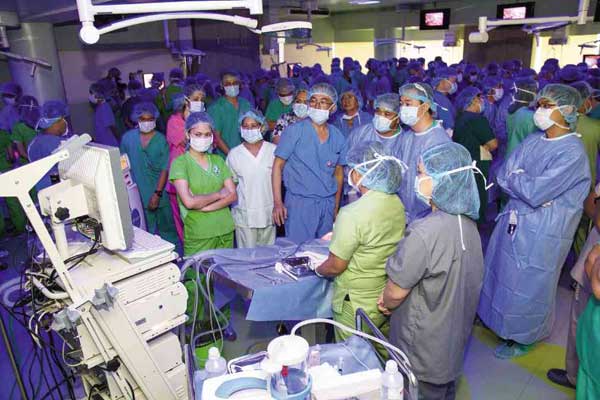
MEDICAL practitioners, mostly surgical residents, consultants, and nurses from all over the country participated in the pre-opening workshops at the MIS Training Center of Cardinal Santos Medical Center’s Philippine Center for Advanced Surgery.
The benefits of laparoscopic or minimally invasive surgery (MIS) are undeniable, which is the reason why patients who have access to this procedure prefer it to the traditional open procedure.
MIS requires smaller incision that results in lesser visible post-operative scarring, lesser pain and bleeding, and quicker recovery period as opposed to open surgery.
A number of surgeons in the Philippines trained in other countries regardless of the cost. They then apply whatever they have learned here and some of them even train other doctors at a much lesser cost than when training abroad.
“The most basic of the MIS procedures, laparoscopic cholecystectomy or the removal of the gall bladder using the laparoscopy technique has actually been existent in the country since 1990,” says Dr. Alfred Allen Buenafe, executive director of CSMC’s MIS Training Center.
“Training in countries like the United States usually costs a doctor $2,000-$3,000 for lectures alone and at least $5,000 for hands-on training, exclusive of his airfare, daily meals, and hotel accommodation,” he adds.
Buenafe is one of the advocates of MIS in the country.
Cardinal Santos Medical Center (CSMC), which is a part of Metro Pacific Investments Corp. Hospital Group of the PLDT Group of Companies, saw that if more doctors in the Philippines were trained on MIS, more Filipinos would benefit from it.
Training center
THE SKILLS Lab of the MIS Training Center of Cardinal Santos Medical Center has eight state-of-the-art workstations, each of which has endolaparoscopy equipment offering high-resolution imaging, operative microscopes, and robotic devices for surgical practice on live tissues of animals.
The hospital recently opened the MIS Training Center located at CMSC’s Philippine Center for Advanced Surgery (PCAS) in Greenhills, San Juan, Metro Manila, which is hoped to become the major MIS training hub in the country.
“Cardinal Santos Medical Center is leading the way for MIS training as it plans to become the country’s premier academic training institution,” says Pilar Nenuca Almira, president and CEO of CSMC.
Almira says that the center is open not only for doctors in the Philippines but also for doctors from other countries.
The training center houses Dry and Skills laboratories, a 60-seater lecture room for smaller groups, and a 146-seat auditorium for larger groups of trainees. Medical experts now have access to modern surgical facilities and technology enabled learning sessions to be facilitated by seasoned medical professionals in the field of advanced surgery.
The Dry Lab uses virtual stimulation in what is called a “risk-free environment.” Trainees are expected to develop basic and advanced endosurgical skills such as eye-hand coordination skills, knot tying, dissection and suturing using advanced simulation equipment.
The Skills Lab has eight operating workstations where each station consists of endolaparoscopy equipment with high-resolution imaging, operative microscopes, and robotic devises for surgical practice on live tissues of animals.
Courses
According to Buenafe, training may include live surgery transmissions from the main (CSMC) hospital’s Operating Room 6 via “high-definition bi-directional” video conference. They are also looking at “beaming” the procedures to hospitals in other parts of the country in the future.
The center will offer courses on basic and advanced laparoscopic surgical skills at least once a month. Each course with 15-20 trainees is expected to last for two to three days.
The physical structure of the training center costs about P200 million, according to Augusto Palisoc Jr., president and CEO of the MPIC Hospital Group. The hospital teamed up with medical endoscopy systems firm Olympus for the training center’s equipment and facilities.
CSMC is a tertiary hospital and academic institution and known for its expertise in the fields of brain, spine, the heart, and cancer, pediatrics, obstetrics and gynecology, pulmonary medicine, nephrology, urology and rehabilitation medicine. Its sister companies under MPIC include Asian Hospital and Medical Center, Davao Doctors Hospital, De Los Santos-STI Medical Center, Makati Medical Center, Our Lady of Lourdes Hospital, and Riverside Medical Center.